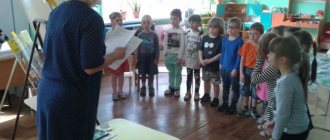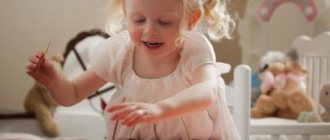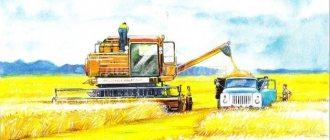Preview:
Summary of a lesson in the senior group on familiarization with fiction.
Reading the Russian folk tale “Khavroshechka”.
Target. Remember Russian folk tales known to children. To introduce the fairy tale “Khavroshechka” (in the adaptation of A.N. Tolstoy), to help remember the initial phrase of the work. Develop the ability to distinguish fairy-tale situations from real ones.
— expand children’s knowledge about Russian folk tales;
- strengthen the ability to distinguish a fairy tale from other literary works;
- teach children to analyze a fairy tale;
- learn to understand the emotional and figurative content of the work.
_ to cultivate a love for Russian folk art;
- cultivate manifestations of good feelings towards each other;
— develop interest in Russian folk tales;
— to introduce children to the origins of Russian culture;
- develop thinking, imagination, visual memory, observation;
— develop children’s cognitive and speech activity, expand their vocabulary;
- enrich children's emotions.
Methods and techniques:
Visual (show, demonstration);
Verbal: Audio recording of a fairy tale and demonstration of illustrative material. Dialogue in roles.
Gaming: organizational moment; physical education, final part
Preliminary work: examining illustrations for fairy tales, toys, reading Russian folk tales, composing descriptive stories based on subject pictures. Working with parents.
Vocabulary work: canvases, liquid,
Preparing for the lesson. Exhibition of Russian folk tales, illustrations for fairy tales, a book with the fairy tale “Khavroshechka”, finger theater.
Let's stand in a circle. Look, what is this?
Educator: This ball is not simple, but magical. He will help us get into the story. To do this you need to say the magic words.
You roll, roll, ball, from the ravine to the bridge,
Just don’t rush too much, point the way to the fairy meadow.
Educator: . And here we are in a fairy meadow. What do you see in the fairy meadow? Books. What are these books about? Are you familiar with these fairy tales? How does a fairy tale usually begin? From what words?
Children: Once upon a time, it happened a long time ago, once in a forest, in some kingdom, etc.
Educator: Guys. What do fairy tales usually talk about?
Children: About the adventures of people and animals, about mysterious and magical events.
Educator: Is it possible to guess from the illustration what this fairy tale is about?
Didactic game “Find out the fairy tale and name the heroes.”
Educator: Today I want to introduce you to a new fairy tale, and
in it you will encounter unfamiliar words: canvases, liquid apples. How do you understand them? (Canvas is handmade linen fabric. Pourable apples are ripe, filled with juice, juicy)
Sit down comfortably and listen to a fairy tale called
Educator: What fairy tale words did you hear in the fairy tale?
Children: Khavroshechka will fit into one ear, come out of the other - everything is ready, liquid apples, silver twigs. The leaves are golden.
Educator: why do you think the fairy tale begins with the words: “There are good people in the world, there are worse people, and there are those who are not ashamed of their brother”?
Children: Because these people took Tiny Khavroshechka and overworked her with work: she weaves and spins, she cleans up, she is responsible for everything. And all the master's children knew was to sit at the gate and watch the street.
Educator: What kind of Khavroshechka do you imagine?
Children: Kind, smart, hard-working
Educator: What were the stepmother and her daughters like?
Children: Angry, envious, cunning.
Educator: Who was Khovroshechka’s friend in this fairy tale?
How did you help Khovroshechka?
Children: Helped her do hard work: (Cow) Khovroshechka will fit into one ear, out of the other, and pick up ready-made canvases.
Educator: How did the stepmother find out about this?
Children: She sent her daughters to follow Khavroshechka and Three-Eyes saw everything, how Khavroshechka got into one ear, and came out of the other, and all the work was done, because her two eyes fell asleep, and the third looked and saw everything.
Educator: Which fairy tale hero did you want to be like?
Hey guys, don't be lazy
Get ready to warm up.
We walk softly, like fox cubs
Lesson on getting acquainted with fiction in the senior group
Senior group
Topic: “Visiting the writer S. Ya. Marshak.”
Goals and objectives: To summarize children’s knowledge about the writer and his works. Continue to teach children to memorize poems. To develop intonation expressiveness of speech and artistic abilities of preschoolers.
Cultivate an interest in literature, a desire to get acquainted with the work of Marshak.
Equipment: books by S. Ya. Marshak, illustrations for his works, a portrait of the writer, costume attributes for reading and dramatizing poetry, schematic drawings for memorizing, origami crafts, colored pencils.
Reading to children and listening to audio recordings of works by S.Ya. Marshak. Verbal games and exercises to develop tempo, timbre, melody of speech and logical stress. Learning by heart excerpts from the poems “Mustache - Striped”, “He’s so absent-minded”, “Luggage”, “A Lesson of Politeness” and dramatizing them. Making origami “cat” crafts with children




